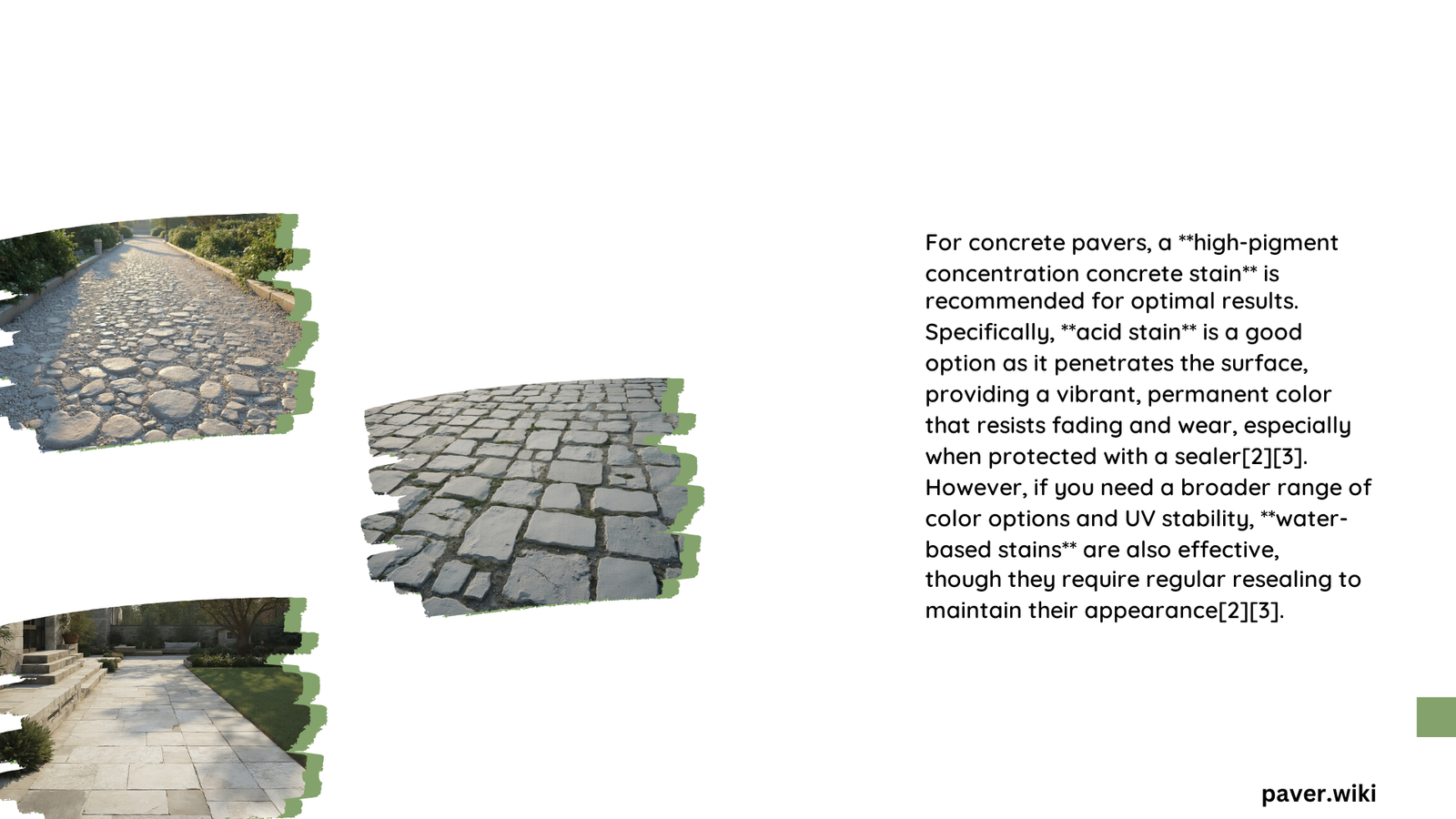When choosing a stain for concrete pavers, the decision often comes down to water-based or acid-based options. Each type has unique properties, affecting durability, application, and aesthetics. Water-based stains offer ease of use and a wide color range, while acid-based stains provide deep penetration and long-lasting results. The best choice depends on specific project requirements, desired finish, and environmental considerations.
What Are the Key Differences Between Water-Based and Acid-Based Stains?
Water-based and acid-based stains differ significantly in their composition, application process, and final appearance:
- Composition:
- Water-based: Acrylic polymers suspended in water
-
Acid-based: Metallic salts in an acidic solution
-
Application:
- Water-based: Easier to apply, less toxic
-
Acid-based: Requires more skill, safety precautions needed
-
Color Range:
- Water-based: Wide range, including vibrant colors
-
Acid-based: Limited to earth tones
-
Finish:
- Water-based: Uniform, opaque
-
Acid-based: Variegated, translucent
-
Penetration:
- Water-based: Surface level
- Acid-based: Deep penetration
How Do Water-Based Stains Perform on Concrete Pavers?

Water-based stains offer several advantages for concrete pavers:
- Easy Application: Can be applied with a sprayer or roller
- Quick Drying: Typically dry within 1-2 hours
- Low VOCs: Environmentally friendly option
- Color Variety: Available in a wide range of hues
- UV Stable: Resistant to fading from sunlight
However, they may not penetrate as deeply as acid-based stains, potentially affecting long-term durability in high-traffic areas.
What Are the Benefits of Acid-Based Stains for Concrete Pavers?
Acid-based stains provide unique benefits:
- Chemical Reaction: Creates a permanent color change in the concrete
- Variegated Finish: Produces a natural, mottled appearance
- Durability: Highly resistant to wear and fading
- Deep Penetration: Bonds with the concrete at a molecular level
- Long-Lasting: Can last 15-20 years or more with proper maintenance
The main drawbacks include a more complex application process and limited color options.
How Do Application Techniques Differ Between Stain Types?
| Aspect | Water-Based Stains | Acid-Based Stains |
|---|---|---|
| Tools | Sprayer, roller, or brush | Acid-resistant sprayer |
| Surface Prep | Clean and dry | Clean, dry, and slightly etched |
| Application | Even coats | Circular motions |
| Drying Time | 1-2 hours | Several hours to a day |
| Safety Gear | Basic protection | Full protective equipment |
| Clean-up | Soap and water | Neutralization and thorough rinsing |
What Are the Cost Implications of Each Stain Type?
The cost of staining concrete pavers varies based on the type of stain:
- Water-Based Stains:
- Cost: $20-$50 per gallon
-
Coverage: Approximately 200-300 sq ft per gallon
-
Acid-Based Stains:
- Cost: $30-$60 per gallon
- Coverage: Approximately 200-250 sq ft per gallon
Additional costs may include surface preparation, application tools, and protective sealers.
How Does Maintenance Differ for Water-Based vs Acid-Based Stained Pavers?
Maintenance requirements vary between the two stain types:
- Water-Based Stained Pavers:
- Regular cleaning with mild soap and water
- Resealing every 2-3 years
-
May require touch-ups for high-traffic areas
-
Acid-Based Stained Pavers:
- Periodic cleaning with pH-neutral cleaners
- Resealing every 3-5 years
- Less likely to need touch-ups due to deeper penetration
What Environmental Factors Should Be Considered When Choosing a Stain?
Several environmental factors can influence stain choice:
- Climate: Acid-based stains may perform better in extreme weather conditions
- UV Exposure: Both types offer good UV resistance, but water-based may require more frequent reapplication
- Moisture Levels: High humidity areas may benefit from acid-based stains’ deeper penetration
- Environmental Regulations: Water-based stains are generally more eco-friendly and may be preferred in areas with strict VOC regulations
How Do Aesthetic Preferences Influence Stain Selection?
Aesthetic considerations play a crucial role in stain selection:
- Color Range: Water-based stains offer a wider variety of colors, including vibrant hues
- Finish: Acid-based stains provide a more natural, variegated look
- Opacity: Water-based stains can be more opaque, while acid-based are typically translucent
- Texture Enhancement: Acid-based stains tend to enhance the natural texture of concrete pavers
What Are the Long-Term Performance Expectations for Each Stain Type?
Long-term performance varies between water-based and acid-based stains:
- Water-Based Stains:
- Lifespan: 10-15 years with proper maintenance
- Color Retention: Good, but may fade faster in high-traffic areas
-
Reapplication: May require more frequent touch-ups
-
Acid-Based Stains:
- Lifespan: 15-20 years or more
- Color Retention: Excellent, due to chemical bonding
- Reapplication: Rarely needed, except for sealer renewal
Which Stain Type is Better for DIY Projects?
For DIY enthusiasts, each stain type offers different challenges:
- Water-Based Stains:
- Pros: Easier application, faster drying, less toxic
-
Cons: May not achieve the same depth of color as professional application
-
Acid-Based Stains:
- Pros: Unique, professional-looking results
- Cons: Requires more skill, safety precautions, and careful application
Water-based stains are generally recommended for DIY projects due to their ease of use and forgiving nature.
In conclusion, the choice between water-based and acid-based stains for concrete pavers depends on various factors including desired aesthetics, durability requirements, application expertise, and environmental considerations. Water-based stains offer ease of use and a wide color range, making them ideal for DIY projects and those seeking vibrant hues. Acid-based stains provide unparalleled durability and a unique, natural look, but require more skill to apply. Consider your specific needs and consult with professionals to make the best choice for your concrete paver project.
References:
1. Brad the Painter: Top Recommended Stains (+How To Stain Concrete)
2. Direct Colors: Concrete Stain for Driveway Guide
3. Direct Colors: Staining Concrete Pavers
